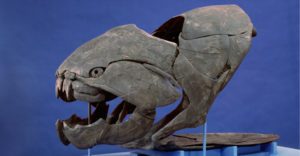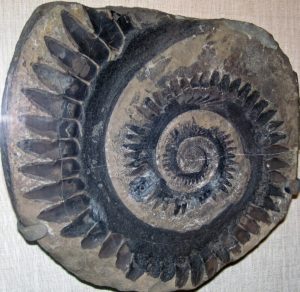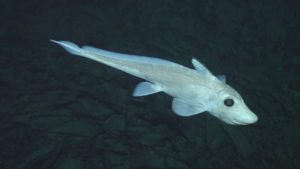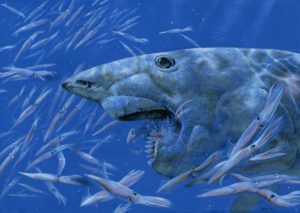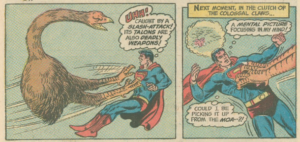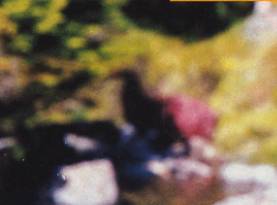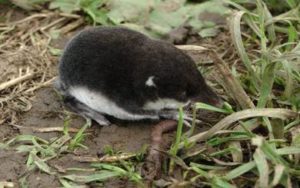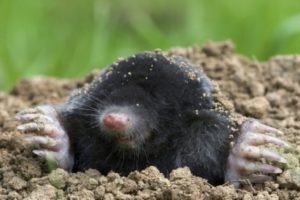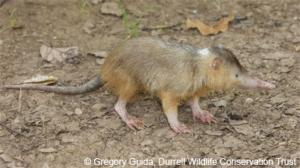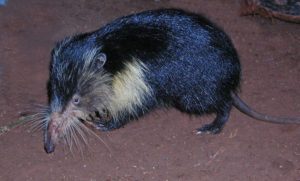Podcast: Play in new window | Download (Duration: 13:01 — 13.3MB)
This week we’ve got a heaping helping of animals with big pointy teeth! Whether you spell it saber or sabre, you don’t want teeth of that description biting you.
Smilodon is the best saber-toothed cat:
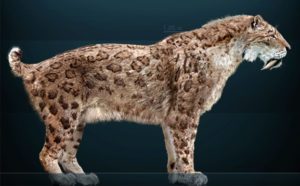
Thylacosmilus’s weird chin bone:
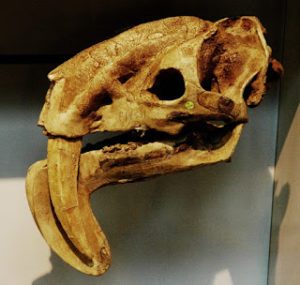
Thylacosmilus might have looked something like this when alive:
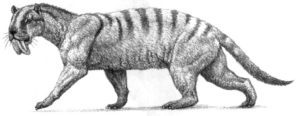
Kolponomos might have looked something like this when alive:
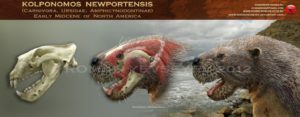
And the sabertooth fish is still alive!
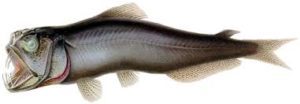
Show transcript:
Welcome to Strange Animals Podcast. I’m your host, Kate Shaw.
For this week’s episode, we’re looking at saber-toothed animals. The animal people generally think of as THE saber-tooth cat, or saber-tooth tiger, is Smilodon fatalis. Smilodon and its relatives were members of the feline family, although not very closely related to the big and little cats living today. We have a whole bunch of Smilodon fossils, many from the La Brea tar pits in California.
Smilodon was probably descended from a saber-tooth cat called Megantereon, which lived in North America, Eurasia, and Africa. It might have still been around only half a million years ago, was definitely around as recently as 2.5 million years ago, definitely around as long as 4.5 million years ago, and recent finds have been tentatively dated to 7 million years ago. So Megantereon was a very successful animal. It was stocky with strong forelimbs and neck, with long upper canines—not as big as Smilodon’s, but certainly saber-toothed. It wasn’t a giant cat, probably close to a jaguar in size, with males probably being around 5 or 6 feet long (or around 1.5 meters) not including the tail and a little over 2 feet high at the shoulder, or 72 cm. It probably killed its prey by leaping on it and biting its throat.
Megantereon probably acted a lot like a leopard, including climbing trees, but its descendant, Smilodon, was too heavy for tree-climbing. Smilodon was a big, tough kitty about the size of a modern lion. It lived in North America, and migrated into South America at some point too. It probably looked more like a bear than a cat since it was stocky, heavily muscled, and had a broad head and jaws that could open much wider than modern cats’.
Smilodon cubs didn’t have saber teeth. A cub only started growing its big teeth when it was around a year and a half old, and by around three years old the fangs were fully grown, about 7” long or 18 cm. Very few remains of young Smilodons have been found in the La Brea tar pits, so researchers think cubs were mostly fed and cared for by their mother until they had fully grown fangs and had learned to use them.
For a long time researchers thought Smilodon lived in forested areas, but recent studies show that it probably preferred open areas. One 2016 study compared carbon and nitrogen isotopes found in collagen samples from bones of Smilodon and other predators with those of prey animals in South America to find out what they were eating. It turns out that Smilodon ate a lot of Megatherium and other giant ground sloths, as well as a camel-like ungulate called Macrauchenia. There’s even some evidence that Smilodon may have hunted in family groups. Overall, the finding suggests that Smilodon lived a lot more like modern lions do than like other big cats.
The first Smilodon fossils found date to around 2.5 million years ago, but remains found in Florida dated to 5 million years ago have recently been described as a related saber-toothed cat. Smilodon lived until only 10,000 years ago at the end of the Pleistocene. It preyed on ice age megafauna and researchers think it may have died out when its main prey animals went extinct. Humans probably had something to do with their extinction too.
Smilodon wasn’t the only big predator in North America during the ice age, though. It wasn’t even the only big feline predator. It shared its territory with the American lion and the American cheetah. Neither of those had saber teeth but they’re awesome so I’m going to tell you a little bit about them anyway.
The American lion died out at the same time as much of the other ice age megafauna, around 11,000 years ago. Unlike Smilodon, it’s closely related to modern big cats—in fact, most researchers consider it a subspecies of the modern African lion. We don’t know for sure if the males had manes, but we do know that the American lion was much bigger than modern lions although not as heavy as Smilodon. It probably stood almost four feet tall at the shoulder, or 1.2 meters. Remains of American lions have been found in the La Brea tar pits so we know they shared territory with Smilodon.
The American cheetah lived on the prairies of North America. Its body plan resembled the modern cheetah’s and it was built for speed, but researchers aren’t sure if it was actually closely related to the modern cheetah. It may be more closely related to the cougar. It was a little larger and heavier than a modern cheetah. Either way, it’s probably the reason why pronghorn antelopes are so fast. They can run over 55 miles per hour or 88 km per hour, much faster than gray wolves and cougars, their current predators. The American cheetah died out around 12,000 years ago.
There are a lot of saber-toothed cats known to science, all related to Smilodon. But there are other animals with similar teeth that are unrelated to the saber-toothed cats. Thylacosmilus atrox looked superficially like a saber-toothed cat. It lived in South America, with most fossils found in Argentina, and went extinct close to three million years ago, long before Smilodon appeared in South America. But Thylacosmilus wasn’t a feline at all. It wasn’t even slightly related to felines. In fact, it was a marsupial, sometimes called a pouched saber-tooth because marsupials keep their babies in pouches, like kangaroos and possums.
Thylacosmilus was about the same size as Megantereon or a modern jaguar. Its saber-like canines were bigger than Smilodon’s and had roots so deep they were practically pressed up against the braincase. But it had something no saber-toothed cat had. Its lower jaw had a pair of bony downward projections called flanges. Think of it as a chin that went horribly wrong. The chin bones pointed downward at the same angle that the fangs pointed downward, and apparently protected them. Researchers aren’t sure if the fangs were actually inside the mouth or just pressed up against the outside of the chin.
Like Smilodon and its relatives, Thylacosmilus had immensely powerful forelegs that it used to grapple prey. But its jaws were weak. Smilodon’s jaws were much weaker than a big cat’s, but Thylacosmilus literally couldn’t outbite a domestic cat. Researchers think it grappled and subdued its prey with its forelegs, then delivered a precision bite with its fangs that severed the animal’s windpipe or major neck arteries. To do this, it didn’t need a strong bite, it needed strong neck muscles, and that’s exactly what it had.
Kolponomos was another saber-toothed animal, totally unlike Smilodon except for its teeth and powerful neck muscles. It’s related to bears, but that branch of the bear family also gave rise to pinnipeds like seals. Kolponomos lived around 20 million years ago along the Pacific coast and used its fangs not to bite the necks of its prey, but to pry shellfish off of rocks. Its snout was narrow and sloped downward, but we don’t have a complete skeleton so we don’t know how big it was or what it really looked like, but it probably resembled a buff sea otter with big fangs more than a seal or bear.
Clearly, saber teeth have evolved multiple times in different types of animals to serve different purposes. They’re not a recent development, either. 250 million years ago, just before dinosaurs evolved and took over the world. An animal called a gorgonopsid, or gorgon for short, lived in what is now Africa and Eurasia. Not a whole lot was known about it until 1998 when a very nearly complete skeleton was discovered in South Africa.
Complete skeletons are almost never found in the fossil record. Dinosaur and other animal skeletons displayed in museums are usually assembled from different individual animals. Sometimes a particular bone has never been found at all so scientists have to make an educated guess. But this gorgon looked like it had died and just flopped over. Nothing ate parts of it, nothing scattered its bones after it decayed. There it was, just waiting for the paleo team to find it.
Gorgon wasn’t a mammal. It wasn’t exactly a reptile either. It was a precursor to mammals, a reptilian creature with mammalian characteristics. It resembled a lion crossed with a monitor lizard, although researchers aren’t sure if it had actual fur or both bristles and scales. It was big—some ten feet or 3 meters long with saber-tooth fangs nearly 5” or 12 centimeters long. Reptiles living today have legs that stick out from the sides of their bodies, so when they walk their bellies are very close to the ground, but gorgon’s stance was different. Its walk probably resembled what’s called the “high walk” of crocodilians, where the gator lifts its body and tail off the ground entirely to walk more easily and quickly on land. Researchers think gorgon hunted by ambushing its prey and delivering a massive bite, then retreating to wait for the injured animal to weaken. This is similar to how komodo dragons hunt.
Gorgon died off in the Permo-Triassic extinction event 250 million years ago. Everyone knows about the Cretaceous-Paleogene extinction that ended the rule of the dinosaurs, but the Permo-Triassic extinction was even worse. More than 95% of all marine animals died out, and some 70% of land animals. Even a lot of insects went extinct, and some evidence suggests that a lot of plants went extinct too. Scientists don’t know what caused the extinctions, but it might have been a meteor strike like the one generally accepted to have caused the Cretaceous-Paleogene event. Whatever happened, it hit marine life hard because the oceans became extremely acidic due to increased CO2 levels in the air and the increased temperature at the ocean’s surface in many areas—104o F or 40o C. It took millions of years for the oceans to recover.
So far all the animals in this episode are extinct. While a lot of living animals have fangs of one kind or another, there don’t seem to be any that use their fangs the way saber-toothed cats did. But I don’t want to leave you after saying, “Yeah, something happened and everything DIED,” so I’ll finish up by talking about the sabertooth fish, of the family Evermannellidae. It’s alive and it’s wonderfully creepy.
The sabertooth fish lives in the depths of tropical and subtropical waters. It has tubular eyes that point upwards so it can see its prey, mostly squid, silhouetted against the far-off surface. It’s grayish-brown in color with a greenish iridescence. Its fins are brown. It has smooth skin without scales and a big mouth that can open extremely wide, which is good because the sabertooth fish can swallow prey that’s actually bigger than it is. Its stomach distends to hold whatever can fit down its gullet. This sounds terrifying, especially when you look at its teeth, but keep in mind that it’s only about seven inches long, or 18 cm. It has two pairs of curved fangs, one in the upper jaw, one in the lower, with smaller teeth in the back of its mouth. If you’ve ever tried to catch a living squid with just your mouth—and I really hope you have not—you’ll probably have noticed that it’s hard to keep the squid from slithering away. Wouldn’t some saber teeth help with that? The sabertooth fish thinks so.
You can find Strange Animals Podcast online at strangeanimalspodcast.com. We’re on Twitter at strangebeasties and have a facebook page at facebook.com/strangeanimalspodcast. If you have questions, comments, or suggestions for future episodes, email us at strangeanimalspodcast@gmail.com. If you like the podcast and want to help us out, leave us a rating and review on iTunes or whatever platform you listen on. We also have a Patreon if you’d like to support us that way. Rewards include stickers and twice-monthly bonus episodes.
Thanks for listening!
